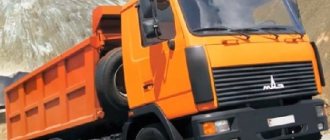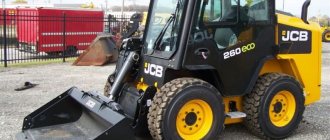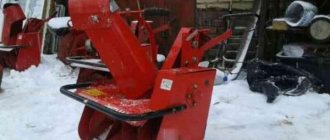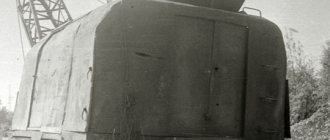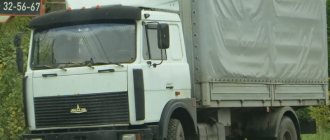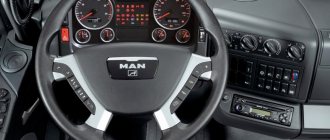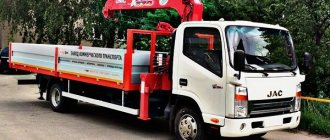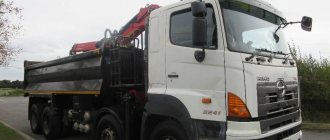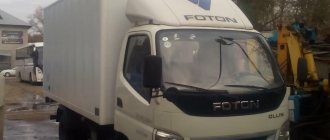MAZ-2000 “Perestroika”: a truck ahead of its time
With the beginning of perestroika, the development of the “road train of the future” began at the Minsk Automobile Plant. Due to the collapse of the USSR, this unique tractor never went into production, and the inventions patented by its authors were later used by foreign manufacturers
Sergey Yakovlev
The development of the “road train of the future” began in 1985. A group of young designers from the Minsk Automobile Plant, led by Mikhail Vysotsky, was given the task of building a long-haul truck of the twenty-first century. No one thought that the project would gain such momentum: during development, MAZ engineers patented more than thirty new inventions, many of which were later purchased by foreign manufacturers.
The first experimental model of the MAZ road train was ready in 1986. The truck was equipped with a MAN D2866 boxer engine with a power of 290 hp. s., which worked in tandem with a 12-speed Mazov gearbox. Gears were switched using an electronic joystick. Thanks to its excellent aerodynamic performance, the MAZ-2000 could reach speeds of up to 120 kilometers per hour. The streamlined body was not the only striking design solution. The cabin doors opened against the direction of the car. In addition, additional fog lights were located on the traction module body, decorative housings were installed between the wheels, the wheels themselves were dressed in caps, and there were mud flaps above them. In the latest experimental modification, the headlights were moved to the lower part of the front wall of the cabin, and the traction module housing was equipped with ventilation meshes. The comfort of the interior could be envied by the most modern foreign analogues: flat floor, high roof, panoramic glass, air conditioning, TV, swivel seat for the second driver, rear view camera and much more. Experts highlighted the roomy body (5-10 cubic meters more than conventional trucks) and impressive aerodynamics as the advantages of the MAZ-2000. The weaknesses were the bulkiness of the design (it was difficult to control both in traffic and in cramped spaces) and the complexity and high cost of maintaining the machine.
However, the main feature of the MAZ-2000 was the use of interchangeable cargo and traction modules in order to repeatedly increase the load capacity without increasing engine power. In other words, use two traction modules for two heavy trailers at once. Thus, the carrying capacity of one road train could be about 80 tons. The designer himself cited the following situation as an example: “Before the high-altitude section of the route, you can roll out the non-driving wheeled cart and replace it with a motor one. In the mountains, the car will work with an additional engine, and on the way back it will leave it at the same motor depot. By changing the number of modules, it will be possible to turn the car into a long road train, increase and decrease the load capacity and power.” The idea of a modular long-haul truck seriously interested not only Soviet industrialists, but also foreign entrepreneurs. Despite the apparent promise, however, it was never possible to bring it to life - to do this, it would have been necessary to completely change the world's ideas about logistics, create a cargo transportation infrastructure from scratch and adopt new technical standards for trucks.
Unfortunately, the collapse of the Soviet Union led to the fact that MAZ engineers had to abandon the serial production of the Perestroika road train due to lack of funds. And, although many of the technical solutions of this prototype were later implemented in more modern production models, the concept itself was abandoned. One of the two manufactured copies of “Perestroika” can still be seen on a pedestal at the entrance to the MAZ plant.
There are only three races left until the end of the season, and there are still five drivers vying for the 2010 Formula 1 World Championship title. However, for McLaren duo Jenson Button and Lewis Hamilton, the odds are diminishing with each Grand Prix. Championship leader Mark Webber is already more than 25 points ahead of the Silver Arrows, but former driver of this team Mika Hakkinen thinks that 75 points for three victories can decide a lot.
Finn is convinced that so far none of the candidates can say for sure that he will become the champion at the end of the season. “There are still a lot of points left, and in Formula 1, as you know, a lot can happen. Of course, if we look at this year’s teams, the fastest car is Red Bull , but no one knows what and how can change in these races.”
The editors recommend:
Why do piston rings stick and how to prevent it?
A traffic police officer searched my car: did he have the right to do so?
Russians may be left without foreign cars: Western automakers have stopped supplying cars to our country
A ship that was transporting cars to Russia was detained in France
Half of the car factories in Russia have closed
News Media2
Discussion Cancel
I want to receive the most interesting articles
Unique characteristics
The low drag coefficient of the MAZ-2000 made it at that time the most streamlined road train both in the USSR and in Europe.
Improved aerodynamics have contributed to significant improvements in the truck's fuel efficiency and dynamic performance.
The prototype of the new generation road train also had the following technical solutions that were innovative for the 1980s. Wheel fairings, aerodynamic cab shape and fiberglass panels.
Some technical solutions of MAZ-2000. For example, a flat cabin floor, a panoramic windshield and a cabin separated from the chassis. Contrary to popular belief, although they were revolutionary for the Soviet automotive industry. But they were still borrowed from the Renault Virages VE-10 concept car, presented in 1985.
Shortcomings and unpreparedness of road infrastructure
Despite a number of advantages, the modular road train scheme at that time was not used anywhere in the world.
Except for Australia with its peculiarities of way of life.
Due to the need to radically remake the cargo transportation infrastructure.
And also revise the standards regulating technical requirements for trucks.
According to some experts, the idea of a modular multi-unit road train may become popular.
In the case of a systematic creation of an international transport corridor from Europe to the Far East.
Examples of neighbors
But if you look closely, Renault does not have a front rotating module
Renault has a large sleeping compartment behind the cabin, not above it
Renault has a conventional saddle for semi-trailers, while the MAZ 2000 has a cabin module attached to the front of the semi-trailer
Entrance to the Renault cabin in an unusual place
In general, Renault is an ordinary tractor with a large cab module and good cabin aerodynamics. Plus the chassis, so there are almost no similarities with the MAZ-2000 and there is no need to talk about copying
In general, Renault didn’t go beyond the concept. And in the end they will create a Renault Magnum, which will drive on the roads in the 90s. It will be discontinued in the early 2000s. How expensive to operate compared to its classmates and competitors
As a result, the assembly line now has an ordinary classic tractor with good aerodynamic cab and chassis shapes. MAZ also now produces tractors similar in appearance, which are among the cheapest in Europe.
But Renault also had a car with a sleeping bag over the cabin. But this is an ordinary truck, nothing like the MAZ-2000
The situation in the modern world with multi-unit road trains
The only country in the world where such long multi-link road trains have actually been used for a long time is Australia.
Moreover, this is due to a number of factors.
- In general, the population living in the country is small. 25 million people over a vast territory. Including climate restrictions. Most of the mainland country is a hot, lifeless desert. This has resulted in the population mainly living along the mainland's maritime coastline. And the center of the country is almost deserted.
- Flat territory. There are no sudden changes in road height, no sharp turns and similar breaks in the road surface. Huge distances of many thousands of miles. Lack of possibility of recoupment of railways. Few consumers of services. All this led to the construction of mostly two-lane straight roads between the country's coasts. From south to north and from east to west.
- Low vehicle traffic on the roads also contributes to the development of long-distance road freight transport. It is possible for an hour or more, when crossing the mainland, not to meet a single car on your way. There are no difficulties with overtaking long road trains.
- The country's main income is the extraction and sale of minerals to industrial powers. In the land of Australia, almost the entire table of chemical elements named after D.I. Mendeleev. Mining occurs in a variety of places. And there is no point in laying railways there. They don't pay off. Therefore, all transportation is carried out on heavy-duty trucks.
- The driver of such a truck is a low-paid employee. Without education. Despite all the responsibility of such multi-ton cargo transportation. Spending weeks away from home. Hiding from everyday life, wife and children. Making ends meet. There are few people willing to do this kind of work. Therefore, they also save on the number of drivers. Due to an increase in the number of trailers.
Features of Australian multi-link road trains
These are mainly trucks of American origin.
They have very powerful diesel engines with 500 - 1000 hp.
They have enormous traction force.
They take a long time to accelerate from a stop.
And then they pull their trailers and semi-trailers to their destination - the coast of the mainland.
Moreover, most of the transportation is carried out by trucks-road trains. Their main advantage is taken into account - doorstep to doorstep delivery. No extra time spent. For the formation of railway trains at marshalling yards, transshipments from car to car, and the like.
This way they transport literally everything. Construction equipment, livestock, minerals, fuel, building materials and the like.
Transportation of livestock
cabover trucks are also used
What about in Europe?
Moreover, in recent years, we have again seriously thought about cargo transportation on multi-unit road trains in Europe.
The same company Volvo Trucks bought the American truck manufacturing company Mack.
And now she herself has started both supplying and assembling on site from vehicle kits brought there by sea.
They now have assembly of their Volvo trucks in Australia.
Volvo road train in Australia
It should be noted that there were attempts to produce similar road trains in Europe.
But, as they say, they went too far.
We wanted to get a large volume of semi-trailer, plus the comfort of a passenger car.
As a result, visibility and safety suffered.
Why did alternative projects stall?
In all attempts to use a similar tractor (in the picture above on the right).
This did not provide the desired benefits. Especially in bad weather on the highway, visibility was seriously affected. Due to splashing on the driver's low windshield and headlights.
Plus, visual detection of the tractor was difficult. When it moves alone on a road or warehouse area.
And there was very poor visibility when performing maneuvers.
General conclusion
The main feature of the MAZ-2000 was the idea of modularity.
Namely, the use of interchangeable traction and cargo modules.
For a multiple increase in the load capacity of a road train without increasing the power of a separate traction module and engine.
For example, a road train with two bodies and two traction modules had a calculated total weight of about 80 tons!!!
M. S. Vysotsky in the newspaper “Socialist Industry” described the design features of the MAZ-2000 as follows, see below.
Project results
A total of two MAZ-2000 prototypes were built (6x2 and 8x2).
The first of which was cut into scrap metal in 2004.
The second, as a monument, was installed at the central entrance of the Minsk Automobile Plant in 2010.
How are similar projects developing today?
But the same Volvo company did not abandon the idea of a similar tractor. And I decided to equip my similar development with a bunch of sensors and cameras.
Plus artificial intelligence control for experimental transportation.
Along pre-measured highways.
For possible dangers to others.
To transport goods in this way without drivers between warehouses in large cities.
As they say, there will be savings on drivers.
Plus round-the-clock transport.
No need for rest.
And given the short distances in Europe, good roads and service, everything may well work out for them.
There were other similar projects. See photo below.
Description
The main features of the new truck were to be modularity and a certain unification. Thanks to them, the carrier could quickly assemble a car from a certain set of “cubes.” Moreover, the kind that was needed exactly at the moment. The first experimental sample of this car was created from the following “cubes”:
- a cargo platform on a supporting frame; subsequently it was proposed to convert this unit into interchangeable bodies;
- transport module - driven wheels with additional equipment and fastening parts;
- a new and completely redesigned control cabin, more about it below;
- frame module - to connect all parts together;
- traction module, on which the power plant and drive wheels were mounted.
The steering control was separated into a separate unit. There were powerful hydraulic cylinders and other parts that rotated the front part of the entire road train.
It is interesting that the designers managed to eliminate the dead zone between the rear wall of the cab and the cargo trailer itself, which is characteristic of the entire line of road trains. Thanks to this, the volume of the body immediately increased, and aerodynamics also improved.

